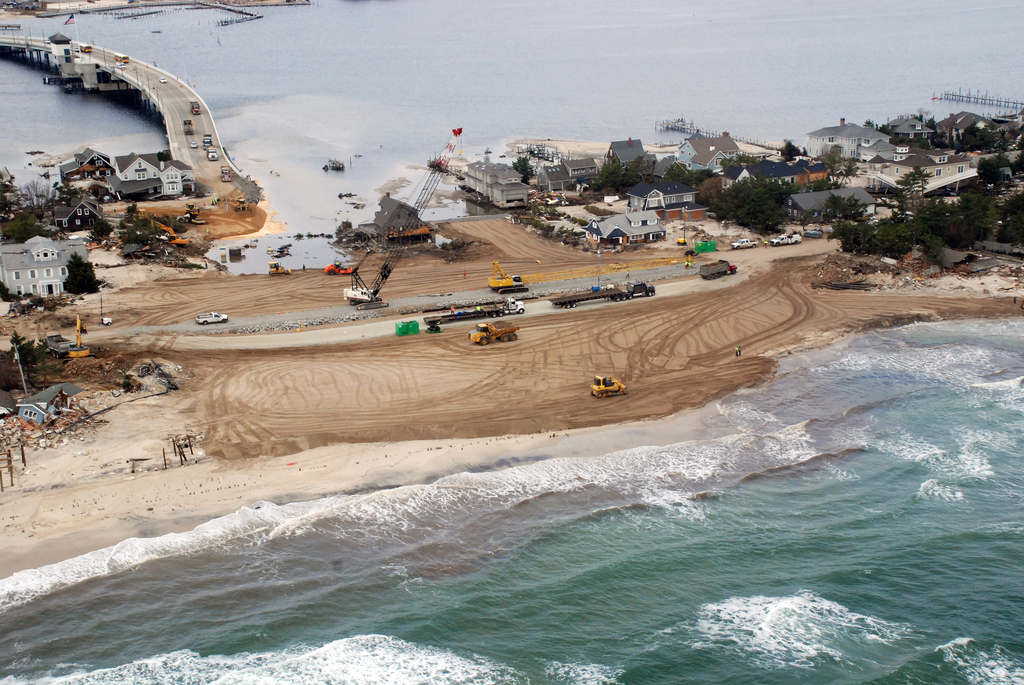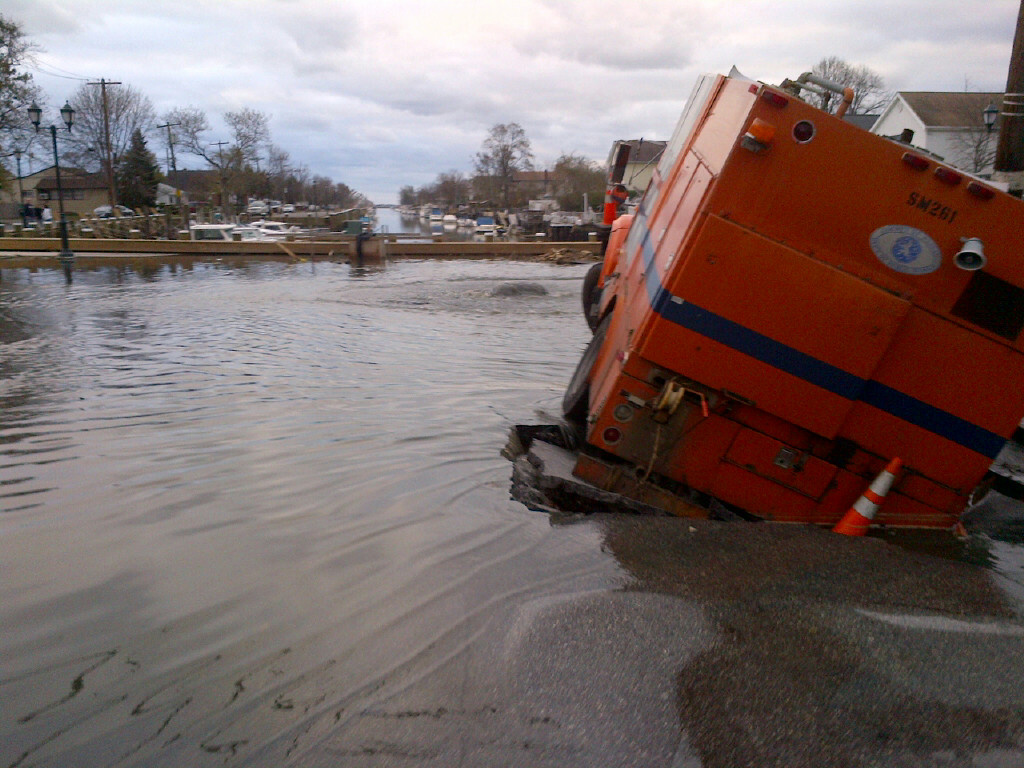After Superstorm Sandy, Leaders Assess Disaster Plans and Mull Climate Change Adaptation
Water utilities prepare for bigger storms and rising seas.

Brett Walton
Circle of Blue
In the nearly $US 80 billion wake of Superstorm Sandy, the second-most expensive U.S. storm disaster, state legislators and water utility leaders have spoken openly and at length about how climate change will test the nation’s water and wastewater infrastructure in unprecedented ways.
The call for action now rings out from the nation’s highest halls of power. On November 15, at a U.S. Senate hearing on a water infrastructure bill — and while at least one wastewater treatment plant in New Jersey continued to pour partially treated sewage into New York Harbor — the Environment and Public Works committee came just short of holding hands to rally support for federal spending to strengthen America’s ports, levees, water treatment facilities, and navigation channels against the lash of destructive storms and rising seas. Committee chair Barbara Boxer (D-California) even added a new section to the legislation directing the Army Corps of Engineers to restore coastal ecosystems to act as a storm buffer.
“The storm sounded the alarm that the federal government must invest in infrastructure,” said Frank Lautenberg (D-New Jersey) during the hearing. “Not only to recover from this storm, but to build it in such a way that it is stronger and that we’re prepared for the next one.”
The committee’s ranking member, James Inhofe (R-Oklahoma), is one of the most conservative members of Congress. Yet at the hearing he proudly claimed to be a big spender in two areas: national defense and infrastructure.
Even Inhofe, though, might blink at Sandy’s damage. Estimates of insured losses because of Sandy range from $US 16 billion to $US 25 billion, and the total economic losses, first estimated at $US 50 billion, continues to rise. This week, Governor Andrew Cuomo (D-New York) pegged storm damage to his state at $US 33 billion, while Governor Chris Christie (R-New Jersey) estimated a bill of nearly $US 30 billion for the Garden State. Add the costs of new flood prevention measures and the two states have requested nearly $US 79 billion from the federal government.
“When people lose things, they become more sensitive and aware,” said Jeff Sterba, the chief executive of American Water, which serves more customers than any publicly traded U.S. water utility, in an interview with Circle of Blue. “But that’s a hard way to do it.”
Planning for Now and Later
If “sustainability” was the environmental buzz phrase of the last two decades, then “resiliency,” a concept with deep roots in many academic disciplines, might be the new coin of the 21st century public policy realm as utilities prepare for rising seas and fiercer storms.
“Resiliency is two-fold,” explained Paul Fleming, manager of climate change initiatives at Seattle Public Utilities. “It’s how to limit damage and how to accelerate the ability to bounce back.”
Superstorm Sandy made such thinking relevant at the national level. Local government officials from coast to coast, after all, have acknowledged for years the threats that a warming world pose to water and sewer infrastructure. One of the first such assessments for the New York City metro area was published in 2001.
Rising seas, higher tides, and bigger storm surges put wastewater treatment plants at risk of flooding – especially those which are located along rivers and coasts. Local concerns were confirmed this week by new research from European and American scientists published in the journal Environmental Research Letters, which found that the seas are rising 60 percent faster than previous estimates.
Not only that, but the deluge of water from a heavy storm can inundate a plant’s treatment capacity and force utilities to let untreated sewage flow downstream, where it might foul drinking water supplies, force beach closures, and threaten public health.
Immediately following a storm, the most urgent demand is to return drinking water and wastewater plants to full operations as quickly as possible.
CH2M Hill, a global engineering firm based in Colorado, has a contract with the North Hudson Sewage Authority to operate a wastewater plant in Hoboken, New Jersey, across the river from Manhattan. During Sandy, the plant was submerged in a 4.3-meter (14-foot) storm surge and its equipment was flooded.
Elisa Speranza, the president of the CH2M Hill’s operations and maintenance group, said that the plant’s pump stations were back online by October 31, two days after the storm hit, but that the plant was not fully treating all sewage until November 9.
“Our disaster preparation paid off,” Speranza told Circle of Blue. “We knew the plant is in a flood-prone area. We had an emergency team ready to fly in and equipment on standby.”
Sterba, whose company operates facilities in New Jersey and Long Island, told Circle of Blue that the biggest problem was losing electrical power to run the treatment plants. American Water had some 200 remote generators as back up, but had trouble getting fuel to them.
“In the same way people were standing in line for gas, we couldn’t get trucks to the plants,” Sterba said.
Those trucks that were able to get through often had no place to store the fuel. As a solution, American Water partnered with municipal governments to use the spare capacity at fire departments and police stations. The lesson, Sterba said, is to set up these relationships long beforehand.
A more bizarre emergency happened to American Water in Nassau County, Long Island, where a sewer pipe broke and created a sinkhole near a street storm drain. A parked county utility truck fell into the sinkhole and ended up breaking a water main that the company operates. The pipe was repaired within 24 hours.
Chronic vs. Episodic
Now that the emergency phase has passed, discussions are turning toward the future. Utilities need to identify, according to Fleming, which assets will be a chronic liability and which would be inundated by infrequent but severe storms. Seattle Public Utilities is using what Fleming calls “forensic meteorology” to look at previous weather anomalies and to pinpoint the types of storms — rivers of moisture-laden air from the tropics or air masses colliding after being split by the Olympic Mountains to the west of the rainy city — that pose the biggest risk.

The goal of all this is to spend precious dollar resources effectively.
“What is the sweet spot?” Fleming asked about climate change adaptation. “How do you achieve resilience and redundancy without breaking the bank? But then you see the cost of Sandy, and you think that it might be cheaper to address these things on the front end.”
The Other Coast
In San Francisco, surrounded by water on three sides, the city’s water utility is already seeing the effects of higher tides and higher seas on its stormwater collection pipes.
The San Francisco Public Utilities Commission anticipates spending $US 20 million to $US 40 million over the next five years to prevent backflow into the pipes, where the salt water can compromise the biological treatment process.
“There are 29 stormwater sites that will go from a nuisance to a problem,” David Behar, the climate program director for San Francisco Public Utilities Commission, told Circle of Blue in February. “We know that these types of impacts will only increase in the future because of climate change.”
The problem for utilities is that they are already looking at billions of dollars in repairs for existing pipes and facilities.
“Even before we talk about the added things needed for resiliency, the basic infrastructure is being neglected,” said Sterba, who noted that, on average, water and sewer pipes in the U.S. are being replaced at a rate of once every 250 to 300 years.
That sentiment — that utilities are barely investing enough to keep up with the infrastructure they own, let alone to make appropriate adaptations — has come up frequently this year in conversations with utility leaders and industry groups and in testimony before Congress.
In 2002, the U.S. Environmental Protection Agency found a gap of more than $US 500 billion between what is being spent on clean water, drinking water, and operations and what is needed over the next 20 years to maintain service. This figure does not include the expenditures necessary to deal with climate change, which the EPA will include for the first time in its next survey of national water infrastructure needs, due to Congress in 2013.
Yet there are signs that new thinking about cheaper, more resilient systems has not only taken root, but is flourishing.
For example, Speranza lived in New Orleans during Hurricane Katrina in 2005. She told Circle of Blue that Katrina was a painful lesson about the cost of losing the storm-deflecting protection of natural vegetation — southern Louisiana’s coastal wetlands, in that case. Since then, from the East Coast’s Philadelphia to the West Coast’s Seattle, and even in Midwestern cities like Milwaukee, city managers have embraced green infrastructure as a complement to the pipes, pumps, and levees that support the urban skeleton.
“Fifteen years ago, green infrastructure would have been derided as ‘hippie infrastructure’ by utility leaders,” said Speranza, who took part in a White House conference on green infrastructure in September.
Such language even found its way into the latest Water Resources Development Act, the federal legislation that sets priorities for water projects managed by the U.S. Army Corps of Engineers. The draft version of the bill, introduced this month, directs the Corps to consider restoring wetlands and sand dunes along the Atlantic Coast, from Virginia to Maine. The evidence in favor of such interventions is fresh – New Jersey towns shielded by sand dunes suffered little damage from Sandy
With the nation’s capital engaged in a seminal debate about taxes, spending cuts, and deficit reduction, will Congress – and particularly the House of Representatives, which has proposed deep cuts to water programs in the 2013 budget – choose to spend more on water infrastructure and on natural flood defenses?
In the next few weeks, the committee and floor will most likely consider a water-infrastructure spending bill. The vote, coming so soon after Superstorm Sandy, will provide a very clear signal about what Congress is prepared to do.
Brett writes about agriculture, energy, infrastructure, and the politics and economics of water in the United States. He also writes the Federal Water Tap, Circle of Blue’s weekly digest of U.S. government water news. He is the winner of two Society of Environmental Journalists reporting awards, one of the top honors in American environmental journalism: first place for explanatory reporting for a series on septic system pollution in the United States(2016) and third place for beat reporting in a small market (2014). He received the Sierra Club’s Distinguished Service Award in 2018. Brett lives in Seattle, where he hikes the mountains and bakes pies. Contact Brett Walton








Trackbacks & Pingbacks
[…] the power goes out — or if those generators are flooded or if fuel isn’t able to reach them, as was the case during Hurricane Sandy, in New York and New Jersey — then raw sewage spills into […]
Leave a Reply
Want to join the discussion?Feel free to contribute!